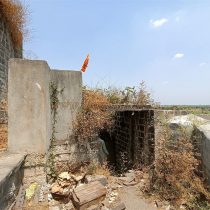DEVGAON KHAWNE
TYPE : FORTRESS
DISTRICT : JALNA
GRADE : EASY
While wandering around the forts of Marathwada, we get to see few ground forts and the exceptional hill forts in each district. Marathwada province is far away from the main Sahyadri range and is mostly flat plains and small hills. Since this area is completely different from the Sahyadri areas, a large number of fortress and very few hill forts were built on the small hills here. These forts and fortress have been in good condition till recent times due to the rule of the Nizam in this area during the pre-independence period. This is why we get to see a large number of fortress instead of ground and hill forts while wandering around Marathwada. Apart from the two forts of Rohilgad and Mastagad, a large number of fortress can be seen elsewhere in Jalna district as well. Even if I assume, there might be a fortress every 30 km’s, it will not be wrong.
...
Looking at the transport system in this area, one should preferably use a private vehicle to travel here. Devgaon Khawane village is at a distance of 20 km from Mantha taluka in Jalna district while traveling towards Lonar. This village is 2 km from the highway and there is a plaque with the name of this village on the highway. Sardar More's Chauburji (four bastions) fortress is in this village. While entering the village, the ramparts of this fortress and the inner entrance in the upper part can be seen from a distance. Approaching the fortress, one can see a bastion built in stone but now somewhat dilapidated. Mr. Amar More, the current descendant of More family lives near the fortress and there is a path to the fortress from his house premises, the part of the fortress that was in use till 2020 collapsed in 2021 and the descendants of More have migrated outside the fortress. As the main gate of the fortress faces north and is currently closed, we enter the fort from the south. The second door of the fortress faces east and there is a well on the right side after entering through this door. At present, it is not possible to go near that well due to the large number of thorn bushes around it. Here there are gatekeeper’s rooms in front and the front part is the work area while the door on the left leads us to the inner living area of the fortress. This place has the main entrance to the fortress and there is a lot of craftsmanship on this door. The lower part of the door is made of stone and the warehouse above it is made of bricks. The facade of the city hall is richly decorated with handicrafts. It is regrettable to mention that the door is carved with stone sculptures and the name of the craftsman who built the fortress is engraved at the base but the date of construction of the fortress is not engraved on it. According to Amar More, the current descendant of the fortress, this fortress is about 350 years old. In the inner part of the fortress there are the remains of an old mansion (wada), the lower floor of that mansion is made of stone and the upper floor is made of bricks. The height of the fortress is about 70 feet from the base and from here the entire village and the distant region can be seen. Half an hour is enough to see the entire fortress. As the entrance to the fort is through the residence of Mr. More, it becomes necessary to take his permission.
© Suresh Nimbalkar













